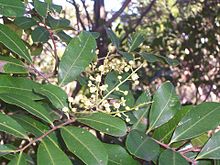Cupaniopsis
| Cupaniopsis | |
|---|---|
 |
|
| Cupaniopsis anacardioides, Tuckeroo, foliage and flowers, Wyrrabalong National Park, NSW, Australia | |
| Scientific classification | |
| Kingdom: | Plantae |
| (unranked): | Angiosperms |
| (unranked): | Eudicots |
| (unranked): | Rosids |
| Order: | Sapindales |
| Family: | Sapindaceae |
| Subfamily: | Sapindoideae |
| Genus: |
Cupaniopsis Radlk. |
| Type species | |
|
Cupaniopsis anacardioides (A.Rich.) Radlk. |
|
| Species | |
|
See text |
|
See text
Cupaniopsis is a genus of about 67 species of trees and shrubs known to science, of the soapberry plant family Sapindaceae. They grow naturally in New Guinea, New Caledonia, Australia, Torres Strait Islands, Fiji, Samoa, Sulawesi, Micronesia. Many species have been threatened with extinction globally or nationally, with official recognition by the International Union for Conservation of Nature (IUCN) and several national and state governments.
Tuckeroo is a common name suffix for some species in Australia.
C. anacardioides has been introduced into the United States, where in some parts they are invasive plants, primarily in Florida and Hawaii, where the common name Carrotwood applies.
At global, national and government regional scales, many Cupaniopsis species have been threatened with extinction, as officially recognised by the International Union for Conservation of Nature (IUCN), governments of Australia, New Caledonia and so on.
Globally, the New Caledonian endemic species C. crassivalvis has become extinct according to the IUCN's 1998 assessment. Seven species endemic to New Caledonia have become endangered with global extinction according to the IUCN's 1998 assessments. Five species endemic to New Guinea, one endemic to New Caledonia and one endemic to Sulawesi have become vulnerable to global extinction according to the IUCN's 1998 and 2010 assessments.
In Australia, C. shirleyana and C. tomentella, small trees today found growing naturally only (endemic) in small areas of south eastern Queensland (Qld), have obtained the "vulnerable" species Australian government's national conservation status and together also with C. cooperorum, the Qld government's "vulnerable" species state conservation status.C. newmannii small trees in eastern Qld have obtained the Qld government's "near threatened" species state conservation status.C. serrata small trees in north-eastern New South Wales (NSW) have obtained the NSW government's "endangered" species state conservation status.
...
Wikipedia
